Today we’re going to dive into the three best closed end funds of all time.
These retirement-changing dividend plays—yielding all the way up to 8.6%!—have not only been crushing all other CEFs, but they’ve been demolishing the S&P 500, as well.
After all, the pundits are constantly telling us that actively managed funds should not beat the S&P 500, and you’d be better off with a low-cost index fund like the Vanguard S&P 500 ETF (VOO).
But these three CEFs have been crushing VOO for years—and they’re on track to keep doing so.
That’s not all they offer—these funds also pay dividends more than three times higher than the S&P 500 average, boosting your nest egg while giving you a much bigger cash stream than you could ever get from index funds.
Market-Crushing CEF #1: A Smartly Run Healthcare Fund Paying 5.9%
Our first fund is the BlackRock Health Sciences Fund (BME), a biotech and pharma CEF that leverages a deep bench of medical experts to identify companies likely to make the biggest breakthroughs—a critical skill in a world dealing with the coronavirus.
The fund has Merck & Co. (MRK.B), which recently bought a firm working on a vaccine for COVID-19, among its top 10 holdings. It also owns medical-device makers Medtronic (MDT) and Baxter International (BAX), as well as Zoetis (ZTS), an animal-health firm that’s positioned to profit from the mass of pet adoptions we’ve seen during the lockdown.
And talk about performance: this 5.9%-yielder’s expertly assembled portfolio has nearly doubled the S&P 500’s return since inception (note that all charts below include these funds’ dividends).
Destroying the Index
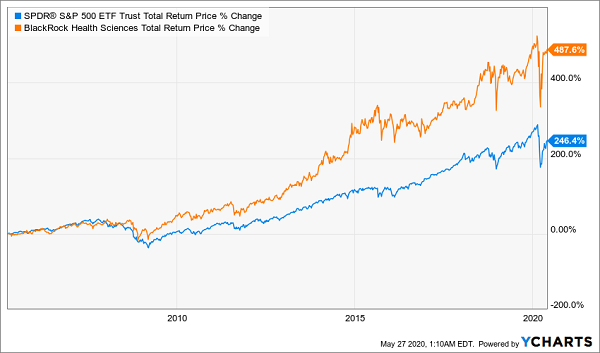
This is a classic example of market expertise and specialization giving an edge that most individual investors simply can’t take advantage of. That’s why BME has become one of the best closed-end funds of all time, with a 15.8% annualized return over the last decade.
Market-Crushing CEF #2: 6.6% Dividends From the Biggest Names in Tech
On BME’s heels is the Nuveen NASDAQ 100 Dynamic Overwrite Fund (QQQX), which holds the stocks in the tech-weighted NASDAQ 100 index, including leading disrupters like Apple (AAPL), Amazon.com (AMZN), Alphabet (GOOGL) and Facebook (FB).
The key thing to remember with QQQX is that it writes call options (a kind of insurance on the portfolio) that give it a cash stream. That is how the fund can deliver a 6.6% yield despite the low- or no-yielding stocks in which it invests. And QQQX has been beating the index for almost all of its history.
Ahead of the Market Again
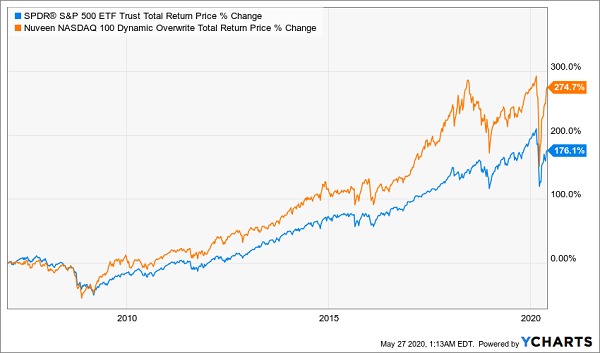
With a 14.9% annualized return, QQQX’s more diversified portfolio gets you less concentration risk than BME with a similar return. Plus, its hedged approach makes it an appealing way to get exposure to tech while mitigating the sector’s sometimes-wild price movements.
Market-Crushing CEF #3: A “Boring” Fund With a Massive 8.6% Payout
Utilities are famous for being dull: with few bankruptcies, accounting scandals or risks to their business models, these firms are a great place to invest for income. This is why the Cohen & Steers Infrastructure Fund (UTF), a utility-focused CEF, can afford to pay an 8.6% dividend.
And there’s nothing boring about this return:
Sleepy Fund Racks Up Huge Gains
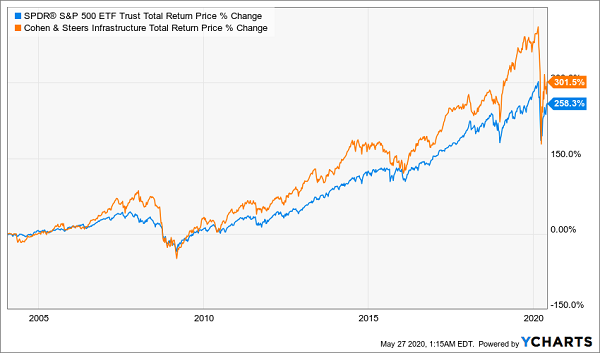
With a 14.2% annualized return over the last decade, UTF has beaten the index and come close to the more volatile tech and pharma funds ahead of it. There’s a reason why UTF is a CEF-investor favorite!
One Last Thing …
Keep in mind that just because a fund has been crushing the market for a long time doesn’t mean it’s a great buy now. These funds have done a great job in the past, but they may not top the CEF leaderboard forever.
We’ve seen this before. For years, the best CEF in the market was the PIMCO Corporate & Income Opportunity Fund (PTY), in blue below, but then BME, in orange, and QQQX, in red, left it in the dust this year:
PTY’s Glory Days Are Over
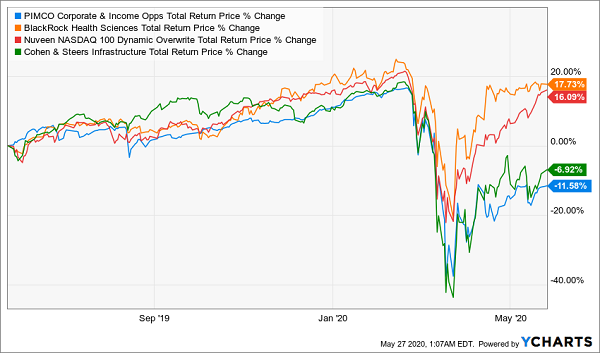
Why? Because these funds were ideally positioned for the COVID-19 crisis. And while UTF (in green) is being challenged, it’s nowhere near as risky as PTY right now. PTY still has an admirable track record, and investors who got in early still beat the S&P 500 by a huge margin.
PTY Is Still a Big Winner
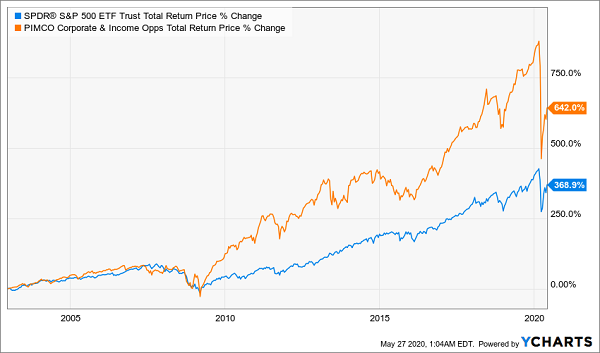
PTY was an ideal buy from 2000 to 2010, but nothing is constant in markets, so its best days are likely behind it. Timing, in investing as in life, is everything.
This, by the way, doesn’t mean you shouldn’t consider BME, QQQX and UTF now—it just means that no matter how good a fund’s history is, we can never afford to “set it and forget it.” We always need to be on guard for changes in the market.
— Michael Foster
5 MORE “Crisis-Resistant” Funds Paying Up to 11% [sponsor]
The beauty of CEFs with huge payouts like these is that they let you beat the market in dividends alone!
Take UTF, whose 8.6% yield crushes the S&P 500’s roughly 7% average long-term total return (including dividends and price gains). Since UTF’s dividend yield crushes that straight out of the gate, you’re already winning here, before you even talk about any price gains.
This is the secret to these CEFs’ outperformance: their massive dividends pushed their total returns well ahead of the S&P 500, which dribbles out a meager 2% average payout.
And we can do even better with the 5 bargain-priced CEFs I’ll show you here. These 5 ironclad funds boast blockbuster yields all the way up to 11%! So you could simply “cherry-pick” that 11% yielder and, by year 9, you’d have recouped your upfront investment in dividend cash alone.
The kicker? This fund trades for 17% below the value of the stocks in its portfolio! That discount is near an all-time high and sets us up for some incredible upside as this unbelievable 17%-off sale winds down (as it must):
An 11% Dividend—for 17% Off!
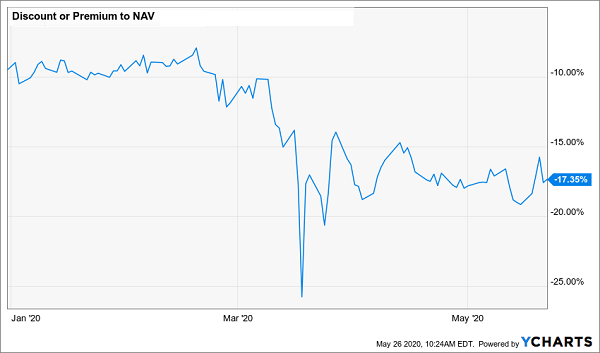
I’m sure you can see the profit (and income) potential on offer here, and I don’t want you to miss out. Click here for full details on this 11% yielder and my 4 other “crisis-resistant” CEFs now: names, tickers, complete dividend histories and everything you need to know before you buy.
Source: Contrarian Outlook

